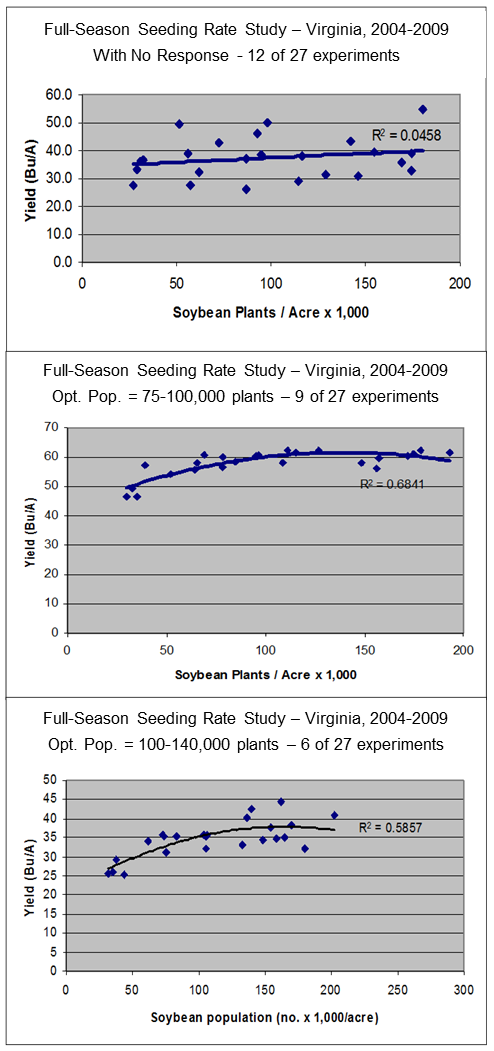My soybean seeding rate recommendation for full-season production systems is to plant enough seed to insure 80,000 uniformly spaced plants/acre. If you cannot uniformly space the plants within a row, then my recommendation rises to 100,000 plants/acre. Based on numerous seeding rate experiments conducted in Virginia, I feel very confident in this recommendation.
Of the 27 full-season seeding rate experiments conducted from 2004 to 2009, I can group soybean yield response to plant population into the following three categories: 1) no response to plant population; 2) optimum plant population of 75-100,000 plants/acre; and 3) optimum plant population of 100-140,000 plants/acre. Below are individual tests that represent these categories.
First, note that these examples only show the response of yield to plant population and do not take into account seed costs. When seed costs are included, the optimum plant population is lower than is shown on the graphs. Also note that these graphs show yield response to plant population, not seeding rate. To convert to seeding rate, adjust these numbers to reflect your expected percent emergence. For example if you assume 75% emergence, you would need to adjust your seeding rate to 133,000 seed/acre to obtain 100,000 plants/acre.
We conducted these experiments with maturity group 4 and 5 varieties. While one may think that more seed might be required for early-maturing varieties, this was not the case (i.e., group 4 and 5 varieties responded similarly).
There may be some correlation with yield potential as listed below:
- 30-40 Bu/A Yield Potential (14 tests)
- 6 required 100-130,000 plants/acre
- 2 required 70-100,000 plants/acre
- 6 had no yield response
- 40-60 Bu/A Yield Potential (7 tests)
- 2 required 70-100,000 plants/acre
- 5 had no yield response
- > 60 Bu/A Yield Potential (7 tests)
- 2 required ~130,000 plants/acre
- 4 required 70-100,000 plants/acre
- 1 had no yield response
So, what do these data mean? It means that every environment (year & location) is a little different and there is no way that we can predict with 100% accuracy the exact seeding rate that will be required for your field in the coming growing season. However, we do know that if we can obtain full canopy closure (90-95% light interception) by full flower (R2 stage) to early pod (R3 stage), we can maximize soybean yield potential. In a dry year or under a droughty soil (low yield potentials), greater seeding rates will help insure this. Still in most cases (30 to 60 bushel yield potentials), 70-100,000 plants/acre are adequate.
What about fields with greater than 60 bushel yield potential? In this case, we need to look beyond adequate leaf area and need to start thinking about how many pods the soybean plant can support. For instance, at 40 bushels/acre and 100,000 plants/acre, we only need to produce 72 seed/plant (using 3000 seed/lb) or about 30 pods/plant (using 2.5 seed/pod). But, at 60 bushels/acre, we need to produce 108 seed or 45 pods per plant; at 80 bushels/acre, we need 144 seed or 60 pods per plant. Considering that 12 reproductive nodes per plant are possible, 4 to 5 pods per node on a rather tall plant would be required. Although branching will also contribute to yield, that seems a lot to ask of one soybean plant. So, if you are trying to win the yield contest or are irrigating soybean, I suggest planting enough seed to obtain 120-140,000 plants per acre in a full-season system; otherwise 80-100,000 plants are adequate.

